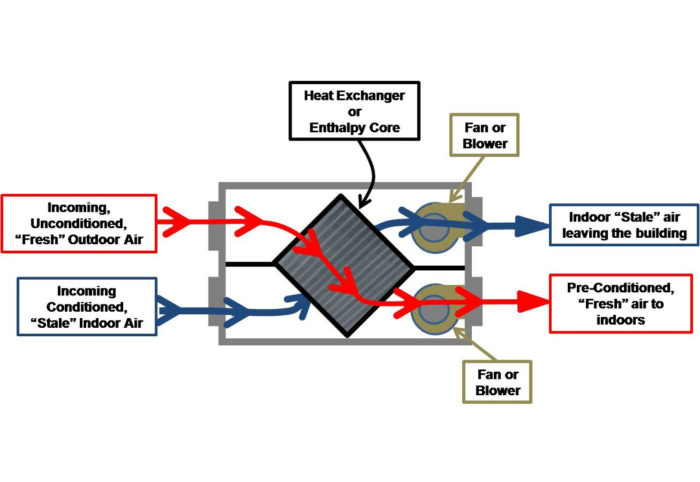The All-Inclusive Overview to the Uses of Heat Recovery Ventilation in Modern Buildings
Heat Recovery Ventilation (HRV) systems stand for a considerable development in constructing modern technology (HRV Heat Recovery Ventilation). They give a technique for exchanging stagnant interior air with fresh outside air while minimizing power loss. This approach not just improves indoor air high quality but additionally adds to energy performance in both residential and commercial structures. Understanding the numerous applications and benefits of HRV can reveal its critical function in modern-day style and sustainability efforts. The effects of this innovation are worth exploring better
Understanding Heat Recovery Ventilation Systems

Although numerous contemporary structures prioritize energy effectiveness, recognizing heat healing ventilation (HRV) systems is important for optimizing interior air quality and minimizing power consumption. HRV systems function by moving heat from stale indoor air to incoming fresh air, successfully preserving comfy interior temperature levels while decreasing power loss. These systems include a warmth exchanger, followers, and ductwork that promote the blood circulation of air. Throughout winter, HRV units capture and reuse heat from the outbound air, while in summer, they can assist cool incoming air. By constantly trading air, HRV systems likewise decrease humidity and the concentration of indoor toxins. Appropriate setup and maintenance of HRV systems are necessary for their effectiveness and efficiency in enhancing overall structure efficiency and comfort.
Benefits of Heat Recovery Ventilation
Heat recovery ventilation systems use many benefits that improve both energy efficiency and interior air top quality in contemporary buildings. By catching and reusing power from exhaust air, these systems substantially lower cooling and heating costs, leading to reduced power usage. They keep a stable circulation of fresh outdoor air, minimizing the threat of indoor air toxins and allergens. This continual exchange assists manage humidity degrees, stopping mold growth and making certain a healthier living setting. Additionally, HRV systems add to sustainability goals by lowering overall carbon impacts. Their capacity to optimize ventilation without sacrificing thermal comfort makes them a beneficial addition to modern building style, promoting both financial and ecological benefits.
Applications of HRV in Residential Buildings
As homeowners increasingly focus on power efficiency and indoor air quality, the applications of heat recovery ventilation (HRV) systems in domestic structures have actually ended up being a lot more widespread. HRV systems are especially valuable in firmly secured homes, where keeping fresh air circulation is necessary for protecting against dampness build-up and indoor contaminants. They properly transfer warm from outward bound stale air to incoming fresh air, decreasing power expenses linked with heating basics & cooling. In addition, HRVs can boost convenience levels by regulating humidity and temperature level. They are additionally versatile for different household styles, consisting of single-family homes and multi-unit structures. Generally, incorporating HRV systems sustains lasting living methods while making sure a much healthier interior atmosphere for passengers.
HRV in Business and Commercial Setups
In business and commercial settings, the implementation of heat recovery ventilation (HRV) systems has become significantly important for enhancing power performance and preserving air high quality. These systems efficiently transfer warmth from exhaust air to inbound fresh air, minimizing the requirement for extra heating or cooling. This not just reduces energy costs yet likewise adds to sustainability initiatives. Industries such as production, warehousing, and workplace structures benefit significantly from HRV systems, as they assist manage temperature level and humidity degrees, making sure a comfortable and effective atmosphere. HRV systems help in removing impurities and excess moisture, boosting indoor air top quality. As guidelines around air quality end up being stricter, the fostering of HRV innovation is most likely to read the full info here grow, making it a crucial element of modern industrial and commercial facilities.
Future Fads in Heat Recovery Ventilation Innovation

Regularly Asked Questions
Exactly How Does Heat Recovery Ventilation Influence Indoor Air Top Quality?
Heat recovery ventilation greatly enhances interior air top quality by continually exchanging stale indoor air with fresh outdoor air while recouping power. This procedure lowers toxins, preserves optimal humidity levels, and guarantees a much healthier setting for occupants.
Can HRV Systems Be Installed in Existing Structures?
HRV systems can undoubtedly be mounted in existing structures. Retrofitting might require adjustments to ductwork and ventilation layouts, but it substantially improves energy efficiency and interior air high quality, making it a practical option for older frameworks.
What Maintenance Is Needed for HRV Equipments?

Are There Details Climates Where HRV Is More Reliable?
Heat recovery ventilation systems are specifically efficient in climates with significant temperature level differences in between seasons. These systems optimize power effectiveness by recovering warmth from exhaust air, making them suitable for both cold and moderately cozy environments.
Just How Do HRV Solutions Affect Power Expenses?
